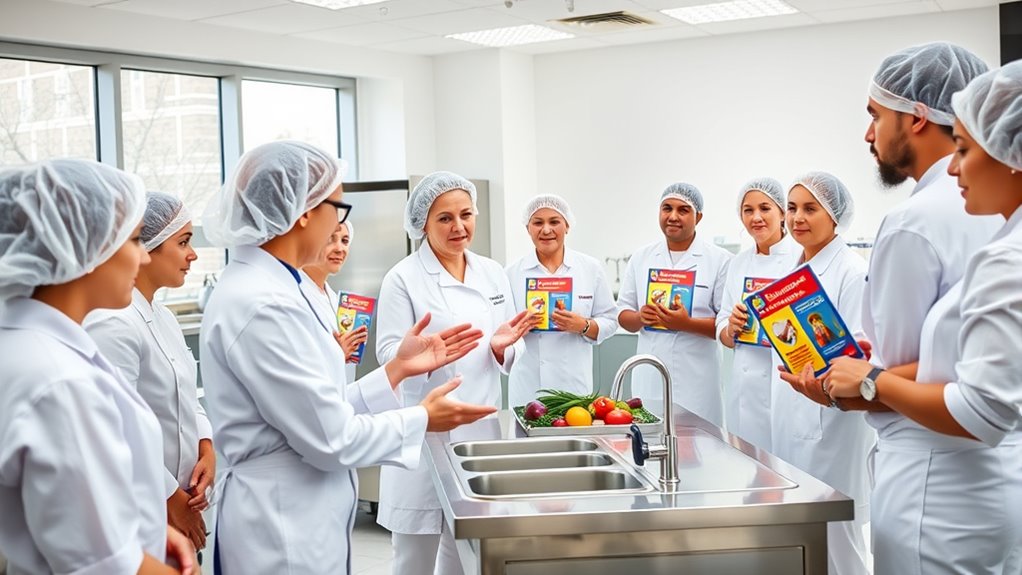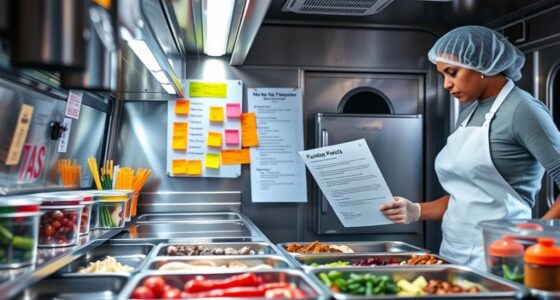Training your staff on food safety and hygiene is vital to prevent contamination and protect your reputation. Focus on teaching proper handling, storage, and sanitation practices, emphasizing personal hygiene like handwashing and clothing. Use engaging, interactive methods, and regularly evaluate their understanding through audits and feedback. Consistent training encourages a safety-first culture. If you want to create a confident, well-informed team, learning more about effective food safety programs will help you achieve this goal.
Key Takeaways
- Develop engaging, role-specific training programs that include interactive elements and real-world scenarios.
- Emphasize the importance of personal hygiene, proper handwashing, and correct work attire to prevent contamination.
- Provide clear guidance on food handling, storage, temperature control, and cross-contamination prevention.
- Regularly evaluate staff knowledge through quizzes, observations, and feedback to identify gaps and reinforce learning.
- Maintain ongoing training updates and audits to ensure compliance with food safety standards and continuous improvement.
Understanding the Importance of Food Safety and Hygiene

Have you ever wondered why food safety and hygiene are so essential in the food industry? Many people believe food safety myths, like bacteria only cause illness or that cleaning surfaces once is enough. These hygiene misconceptions can lead to serious risks, including foodborne illnesses and contamination. Understanding the importance of proper hygiene helps protect customers and your reputation. It’s not just about cleaning; it’s about maintaining consistent practices, understanding cross-contamination, and recognizing that even small lapses can have big consequences. By debunking these myths and emphasizing good hygiene, you ensure food remains safe from farm to fork. Prioritizing food safety isn’t just a rule — it’s a responsibility that safeguards everyone who consumes your products. Additionally, incorporating proper sanitation techniques can significantly reduce the risk of bacterial growth and contamination.
Key Principles of Food Handling and Storage

To keep food safe, you need to control temperatures properly and prevent cross-contamination. Maintaining the right temperatures slows bacterial growth and keeps food fresh. You also have to handle and store items carefully to avoid mixing raw and cooked foods. Using proper food storage techniques and regularly checking temperature controls further enhances safety.
Proper Temperature Control
Maintaining proper temperature control is essential to prevent foodborne illnesses and guarantee food remains safe to eat. You must regularly perform temperature monitoring to ensure foods are stored and cooked at safe levels. For safe cooking, always heat foods to the recommended internal temperature to destroy harmful bacteria. When storing, keep perishable items at or below 40°F (4°C) and hot foods above 140°F (60°C). Use a calibrated thermometer to check temperatures frequently. Avoid guesswork, as improper temperatures can allow bacteria to grow. Proper temperature control not only safeguards health but also maintains food quality. Additionally, understanding temperature zones helps in planning the correct storage and cooking practices. By following these principles, you minimize risks and ensure your food practices meet safety standards consistently.
Cross-Contamination Prevention
Proper temperature control helps prevent bacteria growth, but it’s also essential to stop cross-contamination from spreading during food handling and storage. You should practice food allergen awareness by separating allergenic ingredients from other foods to avoid accidental cross-contact. Use dedicated equipment and utensils for different food types, especially allergens. Implement pest control measures to prevent pests from contaminating food surfaces or storage areas, which can introduce harmful bacteria. Always store raw meats below ready-to-eat foods to prevent drips or spills from contaminating safe items. Regularly sanitize work surfaces, cutting boards, and utensils to reduce the risk of cross-contamination. Additionally, maintaining proper food safety protocols ensures all staff are aware of best practices for preventing contamination. By staying vigilant about these practices, you help protect your customers and maintain a hygienic, safe food environment.
Personal Hygiene Practices for Food Staff

Your personal hygiene practices directly impact food safety, so it’s essential to wash your hands correctly and regularly. Wearing clean, appropriate work attire helps prevent contamination, while monitoring your health guarantees you don’t spread illnesses. Paying attention to these habits keeps both customers and your team safe. Incorporating fabric decorating markers into your uniform customization can also promote a professional appearance and boost team morale.
Handwashing Techniques Properly
Effective handwashing is one of the most important steps food staff can take to prevent contamination. Proper hand hygiene removes bacteria and pathogens that can cause foodborne illnesses. Start by wetting your hands with clean, running water, then apply soap and scrub all surfaces for at least 20 seconds. Rinse thoroughly and dry with a clean towel or air dryer. Remember, handwashing is essential before handling food, after touching your face, or using the restroom. When gloves are used, hand hygiene should still be performed before donning gloves and after removing them to prevent cross-contamination. Incorporating proper hygiene practices ensures a safer food environment.
Appropriate Work Attire Wear
Wearing appropriate work attire is essential for maintaining food safety and preventing contamination in the kitchen. You must follow uniform standards that specify clean, well-maintained clothing suitable for food handling. Dress code enforcement helps ensure all staff wear hairnets, aprons, and closed-toe shoes, reducing the risk of hair or dirt contaminating food. Avoid casual or inappropriate clothing, such as jewelry or loose garments, which can fall into food or harbor bacteria. Regularly check that uniforms are clean and replaced when necessary. Proper attire not only protects food but also builds customer confidence in your establishment’s commitment to safety. Implementing proper hygiene practices is crucial for consistent food safety standards and minimizing the risk of foodborne illnesses.
Personal Health Monitoring
Maintaining personal health is essential for preventing food contamination and ensuring safety in the kitchen. Regular health monitoring helps identify and address any conditions that could compromise food safety. As a food handler, you should:
- Stay alert for symptoms of illness, such as vomiting, diarrhea, or fever, and avoid working until fully recovered.
- Practice good personal hygiene, including frequent handwashing and using gloves when necessary.
- Keep personal health records up to date, ensuring any contagious conditions are reported and managed promptly.
- Understanding the importance of couples’ partnerships can help highlight how shared responsibilities and open communication contribute to a healthy relationship, paralleling the need for teamwork and transparency in maintaining food safety standards.
Cleaning and Sanitization Procedures

To guarantee food safety, it’s crucial that you follow proper cleaning and sanitization procedures regularly. Start by implementing effective cleaning protocols for all surfaces, utensils, and equipment. Use appropriate cleaning agents suited for different materials and ensure you scrub thoroughly to remove dirt and residues. After cleaning, apply proper sanitization methods to eliminate bacteria and viruses. This might include using approved sanitizers at recommended concentrations and contact times. Remember to pay special attention to high-touch areas like sinks, countertops, and cutting boards. Consistent adherence to these steps helps prevent cross-contamination and guarantees a hygienic environment. Keep records of cleaning schedules and monitor the effectiveness of your sanitization methods regularly. Regular use of glycolic acid products for skin care can also support overall hygiene by maintaining healthy skin, reducing the risk of bacterial buildup. Staying diligent in cleaning and sanitization is essential for maintaining food safety standards.
Recognizing and Preventing Cross-Contamination

Have you ever wondered how cross-contamination happens in food preparation? It often occurs when bacteria or allergens transfer from one surface or food to another, risking food safety. To prevent this, you must focus on recognizing risky situations and maintaining strict kitchen safety. Proper equipment maintenance is essential, ensuring tools like knives, cutting boards, and utensils are cleaned and sanitized regularly. Always keep raw meats separate from ready-to-eat foods and use color-coded cutting boards to avoid mix-ups. Be vigilant about Pimple Patch proper cleaning and sanitization of equipment after each use, using separate utensils for different food types, and regularly inspecting and maintaining kitchen tools and surfaces.
Implementing Effective Training Programs

Effective training programs are essential for making sure everyone in your food operation understands and follows proper safety and hygiene practices. To motivate staff, make training engaging and relevant, highlighting how their role impacts safety. Incorporate interactive elements and real-world scenarios to boost staff motivation and retention. Regular training evaluation helps identify knowledge gaps and measure effectiveness, allowing you to adjust content accordingly. Use quizzes, feedback sessions, and observation to assess understanding. Well-designed programs motivate employees by showing you value their development, which encourages compliance and accountability. Consistently refining your training ensures staff stay informed about best practices and emerging safety standards, creating a safer food environment. Incorporating ongoing evaluation and feedback ensures your training remains current and effective. Remember, motivated staff and ongoing evaluation are key to a successful food safety culture.
Monitoring and Continual Improvement of Food Safety Standards

Continuous monitoring is essential for maintaining high food safety standards, as it helps identify potential issues before they become serious problems. Regular audit procedures allow you to assess compliance, spot trends, and verify that staff follow safety protocols. To guarantee ongoing improvement, foster staff accountability by clearly defining roles and responsibilities, and providing feedback. Focus on:
- Conducting systematic audits to evaluate adherence to safety procedures
- Using audit results to update training and address gaps
- Encouraging staff to take ownership of food safety practices
- Leveraging performance metrics to measure and enhance safety standards
Frequently Asked Questions
How Often Should Staff Receive Food Safety Refresher Training?
You should review the refresher frequency for food safety training regularly to guarantee staff stay informed. Typically, a training schedule recommends refresher courses every 6 to 12 months, depending on your industry and local regulations. This helps maintain high hygiene standards and keeps everyone up-to-date on safety protocols. By sticking to a consistent training schedule, you ensure your team remains knowledgeable and prepared to handle food safely at all times.
What Are the Consequences of Non-Compliance With Hygiene Protocols?
Ignoring hygiene protocols can lead to serious consequences. You risk legal penalties, including fines or shutdowns, if non-compliance is detected. More importantly, you jeopardize consumer health, potentially causing foodborne illnesses that harm your customers and damage your reputation. Non-adherence also increases the likelihood of costly legal actions and loss of trust. Staying compliant guarantees safety, protects your business legally, and maintains customer confidence in your establishment.
How Can Training Be Adapted for Different Staff Skill Levels?
You can adapt training for different skill levels by evaluating each staff member’s knowledge and experience first. Use varied training methods like visual aids, hands-on practice, or simple instructions for beginners, and more detailed or advanced sessions for experienced staff. This approach guarantees everyone understands food safety and hygiene protocols, improves compliance, and boosts confidence. Tailoring training methods to skill levels makes learning more effective and keeps your team motivated.
Are There Specific Certifications Required for Food Safety Training?
Imagine walking into a bustling kitchen where certifications hang on the wall, signaling your commitment to industry standards. Certification requirements vary by region and role, but generally, you need recognized food safety certificates like ServSafe or HACCP. These credentials demonstrate your knowledge of safe food handling, helping you meet legal and industry standards. Staying certified guarantees you’re equipped to maintain hygiene and protect customers, making your food safety practices trustworthy and compliant.
How Do Language Barriers Affect Effective Food Safety Training?
Language barriers can notably impact effective food safety training by creating communication challenges. When staff speak different languages or have limited proficiency, instructions may be misunderstood or overlooked, risking safety lapses. To overcome this, you should use clear visuals, translated materials, or bilingual trainers. By addressing these barriers, you guarantee everyone understands safety protocols, reducing risks and fostering a safer, more compliant workplace.
Conclusion
By mastering these food safety and hygiene practices, you’re building a fortress against contamination. Remember, your attention to detail is the glue that holds the entire system together. When you prioritize cleanliness and proper handling, you’re not just following rules—you’re safeguarding customers’ health and reputation. Stay vigilant and committed, because in the world of food service, your actions are the foundation that keeps everyone safe and satisfied.









